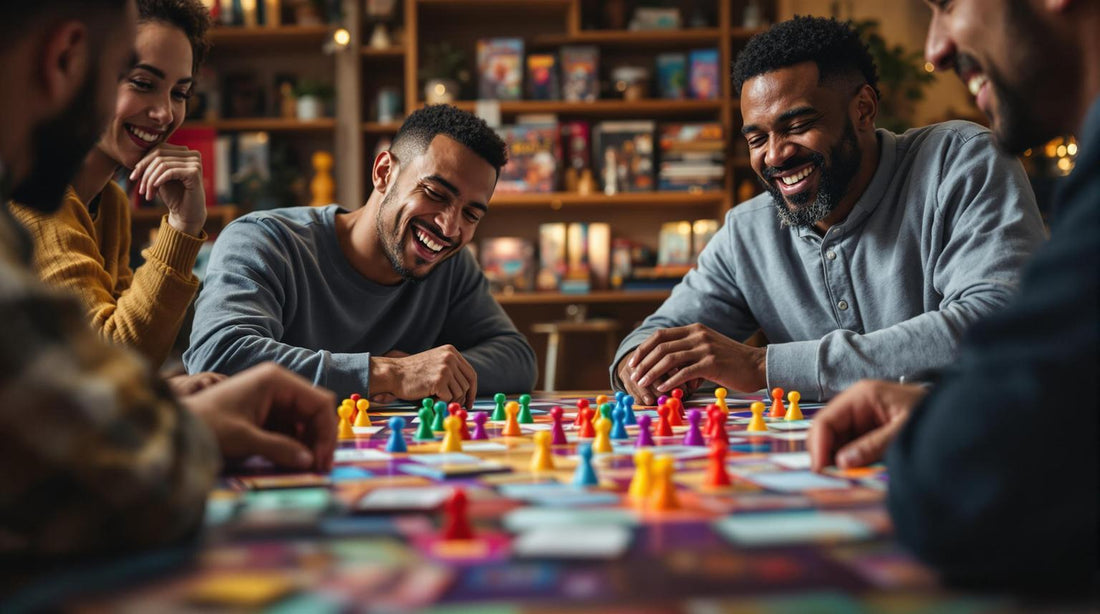Discover the Best Board Games for Every Player

How to Choose Complex Board Games
Choosing the right complex board game can be overwhelming, but it doesn't have to be. Here's a quick guide to help you find the perfect game for your group:
- Understand Complexity: Look for games with the right balance of learning difficulty, strategic depth, and information tracking. Use tools like BoardGameGeek's weight scale (1.0–5.0) to match a game's complexity to your group's experience level.
- Match It to Your Group: Consider player count, skill levels, and time availability. Ensure the game fits your group's preferences, whether competitive, cooperative, or strategy-driven.
- Key Mechanics & Themes: Popular mechanics like worker placement and area control offer engaging challenges. A strong theme can make complex rules easier to grasp and enhance the experience.
- Replayability Matters: Games with variable setups, multiple strategies, and expansions keep things fresh for repeated play.
- Test Before You Buy: Try games through local groups, digital versions, or game store events to avoid mismatched purchases.
Quick Comparison
| Factor | What to Look For | Why It Matters |
|---|---|---|
| Complexity Level | BoardGameGeek weight rating (1.0–5.0) | Matches challenge to your group’s skills |
| Player Count | Works well with your group size | Ensures smooth gameplay |
| Time Investment | Setup and playtime | Fits your schedule |
| Mechanics & Theme | Engaging systems and cohesive themes | Keeps players interested |
| Replayability | Variable setups and multiple strategies | Extends the game’s lifespan |
The TEN Levels of Boardgame Complexity (and Depth!)
Measuring Game Complexity
When evaluating a board game's complexity, it's helpful to use standard metrics. Let’s break down the elements that contribute to this complexity.
Complexity Elements
Three main factors shape a game's complexity:
- Learning Difficulty: How hard it is to grasp and teach the rules.
- Interpretation Density: The amount of information and elements players need to track during the game.
- Strategic Depth: The level of thought required for decision-making and long-term planning.
For example, games like Terra Mystica showcase how interconnected systems - such as resource management, territory control, structure upgrades, and cult influence - can significantly increase complexity. In fact, each step up in a rating scale often feels like a doubling of perceived difficulty.
Understanding these factors makes it easier to compare games using established scoring systems.
Reading Complexity Scores
BoardGameGeek (BGG) uses a 5-point weight scale to measure game complexity:
| Weight Score | Category | Characteristics |
|---|---|---|
| 1.0–1.5 | Light | Simple rules, quick decisions |
| 1.5–2.5 | Medium Light | Entry-level games with basic strategy |
| 2.5–3.5 | Medium | Multiple systems, moderate planning |
| 3.5–4.0 | Medium Heavy | Complex interactions, deeper strategy |
| 4.0–5.0 | Heavy | Intricate systems, extensive planning |
Most games fall within the 2.5 to 3.5 range, offering a balance between accessibility and strategic depth. It's important to note that these scores reflect overall complexity, not factors like playtime or enjoyment.
Another useful tool is the Mogul Scale, which evaluates rules complexity (1–5) and strategic difficulty (A–E). For instance:
- Concordia: Features straightforward card mechanics but deep strategy through resource management.
- Pandemic: Simple rules but requires coordinated player actions.
- Troyes: Combines dice allocation with influence systems, creating layered strategic challenges.
Player Group Assessment
Player Count and Social Factors
The number of players directly impacts how long a game takes and how it plays out. For games with more complex rules, balancing turn structure and player interaction is key to keeping everyone interested. For instance, a game designed for 3–4 players might feel off when played with six, as downtime between turns can drag.
Here are some things to keep in mind about player count:
| Player Count | Best Game Features | Common Challenges |
|---|---|---|
| 2–3 Players | Equal turns, focus on strategy | Less player interaction |
| 4–5 Players | Simultaneous actions, manageable downtime | Longer game sessions |
| 6+ Players | Parallel play options, team modes | Lengthy waits between turns |
"In a 6-player game, each player has fewer turns compared to a 2-player game, so they'll have to focus on shorter-term efficiency. The result is a different experience of playing the same game." - Thibault Schönmann
It's also important to think about your group's skill levels and how much time they're willing to spend learning new rules and mechanics.
Skill Levels and Learning Time
The complexity of a game should match the abilities of the players to ensure everyone has a good time. A game like Race for the Galaxy can be a good way to gauge your group's readiness for more intricate mechanics.
When evaluating skill levels, consider:
- Experience with similar types of games
- Comfort with making strategic decisions
- Patience for going through detailed rules
"A player's perception of the difficulty and complexity of a game is very much based on their own personal experience." - Moe Tousignant, The Tabletop Bellhop
Time and Schedule Factors
Time is another critical factor. Complex games often require a big time commitment for both learning and playing.
For effective scheduling:
- Be upfront about how long the game will take
- Plan sessions ahead of time and allow extra time for learning the rules during the first playthrough
- Stick to shorter campaigns (8–12 sessions) to keep everyone engaged
For example, a game listed as 120 minutes might take an additional 30–45 minutes for setup and rule explanations the first time you play. Consistent scheduling and clear expectations help keep the group invested in longer, more involved games.
sbb-itb-1ed942f
Game Systems and Themes
Core Game Mechanics
Complex board games often rely on intricate systems that encourage deep, strategic thinking. Two standout mechanics in many advanced games are worker placement and area control.
In worker placement games, players use a limited number of worker pieces to perform actions on the board. This mechanic forces players to make tough decisions, as valuable spaces can quickly become contested. Take Agricola, for instance: each player starts with two workers representing their family. These workers must be carefully placed to gather resources or construct buildings, but once a space is claimed, it’s off-limits until the next round.
Key elements of worker placement include:
| Mechanic Element | Strategic Impact | Player Consideration |
|---|---|---|
| Action Blocking | Reduces available choices for opponents | Prioritize critical actions on a crowded board |
| Resource Management | Drives game progression | Balance short-term needs with long-term planning |
While strong mechanics lay the foundation for strategy, a well-executed theme can elevate the overall experience.
Theme and Story Impact
A compelling theme does more than just set the scene - it can enhance understanding and keep players engaged. When the theme aligns with the mechanics, players can grasp complex rules more easily, make intuitive decisions, and stay immersed in the game’s narrative.
For example, games with a cohesive theme allow actions to feel natural within the story. This connection between theme and mechanics not only enriches the experience but also complements the strategic depth discussed earlier.
Long-term Play Value
The staying power of complex board games often comes down to their ability to remain engaging over time. Several factors contribute to a game’s replayability:
- Variable Setup: Different starting conditions lead to unique game states.
- Multiple Strategies: Diverse paths to victory encourage experimentation.
- Player Interaction: Group decisions keep gameplay dynamic.
- Strategic Depth: New layers of tactics and strategies unfold with repeated play.
Games that offer modular elements or expansions can extend their lifespan even further, keeping the experience fresh. Look for games that challenge you session after session, offering opportunities to refine strategies and discover new approaches. These qualities make them ideal for experienced players seeking ongoing engagement.
Research and Purchase Guide
Review Sources
Getting reliable reviews is crucial when you're investing in complex board games. BoardGameGeek is a standout resource, offering detailed game information, user reviews, ratings, and discussion forums. It also provides helpful details like complexity scores and player feedback on game mechanics and learning curves.
Here are some key elements to focus on when reading reviews:
| Review Element | What to Look For | Why It Matters |
|---|---|---|
| Complexity Rating | Scale of 1–5 on BoardGameGeek | Matches game difficulty to your group's skill level |
| Player Count Reviews | Experiences across different group sizes | Ensures the game works well with your group size |
| Setup Time | Actual time needed for preparation | Helps you plan if the game fits your schedule |
| Learning Curve | Feedback from first-time players | Shows how much effort is needed to learn the game |
These insights can help you make an informed choice before committing to a purchase.
Test Games First
Trying out games before buying is a smart way to ensure they suit your preferences and group dynamics. Here are three practical ways to test games:
- Local Game Groups: Many cities have active board gaming communities that meet regularly. These groups are great for trying out games and meeting experienced players who can guide you through the rules.
- Digital Versions: Some complex board games have digital adaptations. While they aren't identical to the physical versions, they can give you a feel for the mechanics and gameplay without a big upfront cost.
- Game Store Events: Local game stores often host demo nights where you can try games with the help of experienced players. These events are a great way to understand complex rule sets in a hands-on environment.
Testing games this way can save you from investing in something that doesn’t match your play style.
Shop Complex Board Games at Brain Games

Brain Games offers a curated collection of complex board games, along with some great perks:
- Game Exchange Guarantee: Not happy with a game? Exchange it within 2 weeks.
- Component Protection: Lifetime guarantee on components for Brain Games–published titles.
- Curated Selection: A well-chosen range of games to suit different player counts and preferences.
When you're ready to shop, consider factors like age range, playtime, replayability, price, and the quality of components to ensure the game meets your needs. These final checks can help solidify your decision after research and testing.
Conclusion
Selection Checklist
When picking complex board games, consider these key elements:
| Selection Factor | Key Considerations | Why It Matters |
|---|---|---|
| Player Profile | Group size, age range, experience level | Ensures the game suits everyone in the group |
| Time Investment | Learning curve, setup time, play duration | Helps you plan around your available time |
| Game Elements | Mechanics, theme, replayability | Keeps the game interesting over time |
| Complexity Level | BoardGameGeek weight rating, rule density | Matches the challenge to your group's skill level |
| Social Dynamics | Competitive vs. cooperative, player interaction | Aligns with how your group prefers to play |
This checklist provides a solid starting point for narrowing down your options.
Next Steps
Once you’ve shortlisted potential games, here’s what to do next:
- Dive Deeper: Watch gameplay videos and read reviews on BoardGameGeek to get a feel for each game. Most complex games fall into three styles: conflict-driven, multiplayer solitaire, or cooperative. Choose a style that fits your group’s interaction preferences.
- Make Your Purchase: When you’re ready, check out Brain Games for a carefully curated selection. They offer a 2-week exchange guarantee and lifetime component protection for their titles. If possible, try out games locally before buying.
The ideal complex board game balances strategic depth with your group’s unique preferences, making it a go-to choice for years to come.






